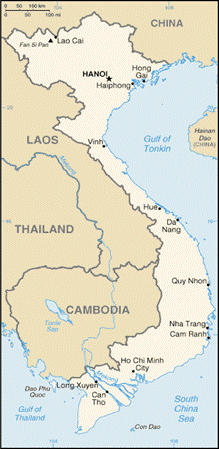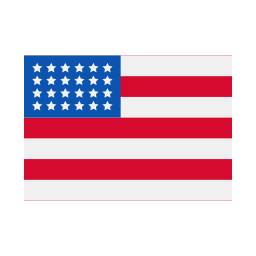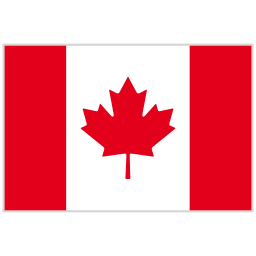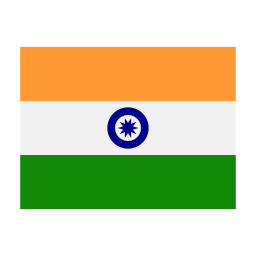VIETNAM – GENERAL INFORMATION

GEOGRAPHY
Vietnam lies within the tropics and is principally agricultural with a central tropical rainforest. The ‘S’-shaped country shares borders to the north with the People’s Republic of China and to the west with Laos and Cambodia. The eastern and southern shores are lapped by the South China Sea and the Pacific Ocean.
Northern Vietnam is dominated by the Red River plains that bisect Hanoi, and the Lo and Chay rivers. To the north and west of Hanoi are green hilly areas; particularly well known is the Sapa Valley. East of Hanoi, Halong Bay features a stunning natural formation of more than 3,000 limestone islands jutting sharply out of the South China Sea.
To the south, it is the Mekong River and its fertile plain that governs the geography and consequently the rice industry. Among the plains, in the middle of the thin country and to the southwest are mountainous areas, known as the highlands, where farmers grow rubber, tea and coffee.
HISTORY
For many years Vietnam formed part of the French colony of Indochina, along with Cambodia and Laos. In 1941, the Japanese occupied Vietnam during their WWII sweep through South East Asia. The resistance to the Japanese was led by the Indochinese Communist Party.

Communist revolutionary Ho Chi Minh established the Viet Minh during WWII in order to gain independence from France. Fighting continued until 1954 when the French surrendered to the Viet Minh at Dien Bien Phu and Hanoi became capital of North Vietnam, but Ho Chi Minh was determined to reunite the whole country.
The USA came to the support of South Vietnam and full-scale war – with the southern Communist guerrillas (known as the Viet Cong), the North Vietnam Army and the Soviet Union on one side, and the Americans and the South Vietnamese Army on the other – broke out in 1965. The Americans withdrew in 1973 and fighting continued until 1975 when Saigon fell to North Vietnamese troops. Vietnam was reunited under Communist rule the following year.
Vietnamese troops occupied Cambodia in 1978 to drive out the genocidal Khmer Rouge regime and stayed there until it withdrew its troops in 1989.
After withdrawing from Cambodia, Vietnam concentrated on rebuilding its own economy and following years of rampant inflation, poverty and repression, the government introduced economic reform or doi moi in 1986, allowing people to own their own businesses. Nonetheless, the Vietnamese economy suffered from the withdrawal of aid and subsidized goods from the former USSR and from Eastern Europe, as well as the continuing US-organized trade boycott instituted after the US withdrawal. Relations with the USA eased after full diplomatic relations were restored in 1995.
Recent reforms resulted in rapid economic growth, until the global crisis in 2008, but there has been no parallel development in the country’s political environment – the Communist Party has no intention of relaxing its hold on political power and has been criticized by human rights groups for increasingly suppressing online dissent and freedom of expression.
THE PEOPLE
Vietnam is home to many nationalities of which the Viet comprise 85%. Their population is concentrated around the Red and Mekong Deltas and the coastal plain of central Vietnam. Some 53 minorities live mostly in the mountain areas that stretch from the North to the South. Ethnic groups in the north generally live between altitudes of 25 meters and 2,000 meters above sea level. The most well-known of these are the Tey (also the most populous), the White Thai and the Black Thai (distinguished by the color of their clothes), and the Hmong (Meo).
In the south, geographic locations of tribes are much more distinct; tribes live in the plains as well as the hills. The Hoa tribe (originated from China) is considered to be the most advanced, but ethnic groups descended from early intelligent civilizations such as the Kingdom of Champa are equally fascinating. Although there is some overlap linguistically and culturally between these tribes, each has its own unique customs ranging from the style of their graves to the design of their houses.
SOCIAL CONVENTIONS
Handshaking and a vocal greeting are normal. Clothing should be kept simple, informal and discreet. Avoid shorts if possible as they are usually only worn by children. Footwear should be removed when entering Buddhist pagodas. Vietnamese people should not be touched on the head. It is also polite to give and receive gifts and business cards using two hands.
LANGUAGES
Vietnamese is the official language.
Vietnamese is a tonal language, comprising six tones in the North and five in the South; accents and some words are quite distinct in three regions, North, Central, and South. Much of the language is Sino/Vietnamese, though influences from minority languages, French and English are also apparent. Thanks to the quoc ngu (romanized script), Vietnamese words, though difficult to pronounce, are easy to read. With the recent liberalization English has replaced Russian as the most studied language and is widely spoken. Vestiges of colonialism remain in a French-literate older generation, especially in northern Vietnam.
GOVERNMENT
The government of Vietnam is a single-party socialist republic framework, where the President of Vietnam is the head of state and the Prime Minister of Vietnam is the head of government, in a one-party system led by the Communist Party of Vietnam. Executive power is exercised by the government and the President of Vietnam. Legislative power is vested in the National Assembly of Vietnam. The Judiciary is independent of the executive. The parliament adopted the current Constitution of Vietnam; its fourth, on 15 April 1992, and it has been amended once since then.
TIME ZONE
Vietnam is 11 hours ahead of Eastern Standard Time (EST)
ELECTRICITY
The voltage is 127/220 Volts; 50 Hz; Plugs A, C & G. You will most likely need a voltage converter, and plug adapter in order to use U.S. appliances, even though some outlets will correspond to American plug types and voltages. We recommend getting a universal adapter and converter kit.
CLIMATE
Because of its geography, the climate in Vietnam varies greatly from north to south with three distinct climatic zones. Tropical monsoons occur from October to April in the centre and from May to September in the north and south. It is almost totally dry throughout the rest of the year. It can get exceptionally hot, however, all year round, but the north has a cooler time between October and April.
Temperatures around the country can reach up to 40C in the height of the hot and rainy season (May to September), but the northern highlands and Hanoi can often seem chilly and damp in the winter.
There is no one ideal time to visit Vietnam as a whole but at any time of year there will be sun somewhere. The high season is from September to March but bad weather can disrupt travel in the centre of the country during this period, particularly from September to December. For the beaches in the centre of Vietnam, Danang, Hoi An and Nha Trang, it is best to go between May and August. The autumn is the best time to visit Halong Bay when there should be clear skies.
CLOTHES TO WEAR
Loose, natural fabrics all year, but warmer clothing is required in the highlands, and in the winter in north Vietnam. Rainwear is essential during the wet season.
LOGISTICAL
Entry & Exit Requirements:
The Government of Vietnam treats the use of falsified travel documents very seriously. Travelers attempting to enter Vietnam for any purpose with an altered or otherwise fraudulent travel document are likely to face criminal prosecution and possible imprisonment.
To enter Vietnam, you need a valid U.S. passport with at least six months validity remaining beyond the date of your arrival and a Vietnamese visa, a visa exemption document, or a written approval letter for a visa upon arrival. You may obtain a visa or a visa exemption document from a Vietnamese embassy or consulate prior to traveling to Vietnam. To obtain a written approval letter, you must contact a travel agency prior to departure for Vietnam. U.S. citizens have reported unscrupulous travel agencies taking advantage of travelers and charging extremely high fees upon landing. If you arrive without an appropriate Vietnamese visa, exemption document, or written approval for a visa upon arrival, you will be denied entry and subject to immediate deportation. Vietnamese visas are usually valid for a single entry, unless the traveler specifically requests a multiple-entry visa, which may incur additional fees. If you plan to leave Vietnam and re-enter from another country, be sure that your visa is multiple entry. If it is only single entry, you will have to obtain another visa prior to returning to Vietnam.
Please be aware that Vietnam has two fees: 1) the visa fee and 2) the visa processing fee. The visa fees are sometimes posted on the Vietnamese Embassy’s website, but U.S. Embassy and Consulate officials have received reports of processing fees that vary from one applicant to another and from one issuing entity to another. We have also received reports of additional fees being charged by Vietnamese officials at land borders. We have brought this concern to the attention of Vietnamese officials, but the problem persists.
Even if you have a valid visa, you may be refused entry into Vietnam. Note that Vietnamese immigration regulations require foreigners entering Vietnam to undertake only the activity for which their visas were issued. Travelers who plan to perform volunteer or charitable work should obtain the correct visa classification before traveling to Vietnam. If you change the purpose of your visit after you have received your visa, you must obtain a new visa appropriate for your new activities before beginning those activities. If you plan to travel from Vietnam to Laos by land, you must obtain the type of Vietnamese visa that adheres to the passport. Lao immigration requires proof that travelers have departed Vietnam, something that can only be shown with an adhesive visa. Vietnamese officials remove detachable visas from passports when travelers depart Vietnam, leaving travelers with no proof of their Vietnam departure. This situation can result in Lao officials requiring the traveler to return to Vietnam.
If your U.S. passport is lost or stolen in Vietnam, you must obtain both a replacement passport and a replacement Vietnamese visa. In the event of an emergency, the U.S. Embassy and Consulate General can issue you a limited validity replacement passport in as little as one day; however, the Vietnamese government requires three to five working days to issue a replacement visa. Neither the U.S. Embassy nor the Consulate General can expedite replacement Vietnamese visas.
Embassy Locations:
U.S. Embassy in Vietnam
170 Ngoc Khanh
Ba Dinh District
Hanoi, Vietnam
Telephone: +(84) (4) 3850-5000
Emergency After-Hours Telephone: +(84) (4) 3850-5000 or (04) 3850-5000/3850-5105
Fax: +(84) (4) 3850-5010
Embassy of Canada to Vietnam
31 Hung Vuong
Hanoi
Vietnam
Tel.: +84 (4) 3734 5000 or in case of problems with the preceding number +84 (4) 8323 5500
Fax: +84 (4) 3734 5049
http://www.canadainternational.gc.ca/vietnam/index.aspx?lang=eng
HEALTH
Medical facilities in Vietnam frequently do not meet international standards and may lack medicines and supplies. Medical personnel in Vietnam, particularly outside Hanoi and Ho Chi Minh City, may speak little or no English. Doctors and hospitals expect immediate cash payment for health services. International health clinics in Hanoi and Ho Chi Minh City can provide acceptable care for minor illnesses and injuries, but more serious problems will often require medical evacuation to Bangkok or Singapore. Although you can purchase many medications at pharmacies without having a prescription, some common U.S. medications are not available in Vietnam. You should bring adequate supplies of medications for the duration of your stay in Vietnam. You may obtain lists of local English-speaking physicians from the U.S. Embassy in Hanoi or the U. S. Consulate General in Ho Chi Minh City. Neither the Embassy nor the Consulate General may recommend specific medical practitioners or hospitals. Emergency medical response services are generally unresponsive, unreliable, or completely unavailable.
Be cautious about drinking non-bottled water and about using ice cubes in drinks. You may wish to drink only bottled or canned beverages or beverages that have been boiled (such as hot tea and coffee).
In July 2012, the Government of Vietnam reported outbreaks of rabies in the northern mountainous provinces of Son La, Lai Chau, Dien Bien, Lao Cai (Sapa) and Yen Bai. Rabies is a preventable viral disease of mammals most often transmitted through the bite of a rabid animal. The most important global source of rabies in humans is from uncontrolled rabies in dogs. In Vietnam, monkeys also pose a risk. Children are often at greatest risk from rabies. They are more likely to be bitten by rabid animals, and are also more likely to be severely exposed through multiple bites in high-risk sites on the body. Travelers in Vietnam should exercise caution around unfamiliar animals and seek immediate medical attention if bitten. For more information on rabies, please visit CDC’s website. Since December of 2007, Hanoi and provinces in northern Vietnam have seen an episodic resurgence of severe acute diarrhea known to be cholera. For more information on cholera, please visit CDC’s website.
Avian influenza (H5N1) continues to be a concern in Vietnam. In Vietnam and other Southeast Asian countries affected by avian influenza, you should avoid poultry farms, contact with animals in live food markets, and any surfaces that appear to be contaminated with feces from poultry or other animals. Read more information about Avian Flu.
Vietnam has an HIV epidemic that is concentrated in certain groups. Thus, although the estimated adult HIV prevalence is only 0.45 percent in the general Vietnamese population, HIV prevalence among people who inject drugs, female sex workers, and men who have sex with men remains high at 13.4 percent, 3 percent, and 16.7 percent, respectively. We recommend that visitors to Vietnam take adequate preventative measures (e.g., avoid injecting drug use and practice sex safe) to minimize their risk of exposure.”
Air pollution is also a significant problem in Vietnam’s major cities, and you should consult your doctor prior to travel and consider the impact seasonal smog and heavy particulate pollution may have on you. Tuberculosis is an increasingly serious health concern in Vietnam. For further information, please consult the CDC’s information on TB.
Information on vaccinations and other health precautions, such as safe food and water precautions and insect bite protection, may be obtained from the Centers for Disease Control and Prevention’s (CDC) hotline for international travelers at 1-800-CDC-INFO (1-800-232-4636) or via the CDC website at http://wwwnc.cdc.gov/travel. For information about outbreaks of infectious diseases abroad, consult the infectious diseases section of the World Health Organization (WHO) website at http://www.who.int/topics/infectious_ diseases/en/. The WHO website also contains additional health information for travelers, including detailed country-specific health information.
BANKS AND CURRENCY
Dông (VND; symbol ₫). Notes are in denominations of ₫500,000, 200,000, 100,000, 50,000, 20,000, 10,000, 5,000, 2,000, 1,000 and 500. Coins are in denominations of ₫5,000, 2,000, 1,000 and 500.
An increasing number of outlets accept MasterCard and Visa. However, outside main towns and cities, it is wise to carry cash. There are ATMs in many major towns, but not in rural areas.
There are plenty of ATMs in major towns, but they can be scarce in rural areas. ATMs issue Dông, and the single withdrawal limit varies, depending on the bank, ranging from ₫2,000,000 to much larger amounts.
Traveler’s cheques are accepted in banks, money changers and some hotels although most travelers now use debit cards because of the increased number of ATMs. It is best to take US Dollar traveler’s cheques to avoid additional exchange rate charges and expect to pay a high commission.
Banking hours:
Varies from bank to bank but generally Mon-Fri 0830-1600; some may close for lunch. Many banks are also open on Saturday morning; all banks are closed on Sunday.
COMMUNICATION
International Dialing Code is +84. It is expensive to call home from hotels but international calls from post offices are much better value. Internet cafés are widely available throughout the country and they are good value. High-speed connections are only available in major towns and cities. Post office hours and days vary from town to town but many can be open from early morning until late evening.
Cell Phone Usage:
Please contact your cell phone provider to determine whether your contract includes coverage in the country you are visiting. Depending on your contract you may have to add international services and/or country specific services.
ENTERTAINMENT
Food and Drink:
Vietnamese cooking is varied and usually superb, as the profusion of Vietnamese restaurants in New York, London and Berlin contest. It is a mixture of Vietnamese, Chinese and French traditions, with a plethora of regional variations. As in all countries of the region, rice or noodles usually provide the basis of a meal. Not surprisingly, fish is plentiful. Pride is taken in the fact that the freshest of vegetables are used and the vegetables and fruit served are seasonal.
Specialties:
- Breakfast is often congee (rice porridge) or a meaty noodle soup locally known as pho.
- Nem (spring rolls: pork mixed with noodles, eggs and mushrooms wrapped in rice paper, fried and served hot).
- Banh chung(glutinous rice, pork and onions wrapped in large leaves and cooked for up to 48 hours, to be eaten cold at any time).
- Nuoc mam (Vietnamese dishes are not complete without this fermented fish sauce).
- Bun cha, (grilled pork, cold rice noodles, deep fried rolls and a big bowl of salad leaves).
Regional drinks:
- Soda chanhis a refreshing lime soda served with freshly squeezed lime juice, sugar and ice mixed into club soda.
- Vietnamese coffee grown in the Central Highlands is served thick, strong and black through a drip filter. Sometimes it is served with condensed milk to sweeten it.
- Vietnamese green tea is light and refreshing and served at the end of meals.
- Ruou can(rice wine) is made by members of the Vietnamese hill tribes and drunk straight from ceramic fermentation jars through bamboo straws.
- Bia hoi or fresh beer is produced daily and served ice cold in small, local bars. It is not particularly alcoholic but very refreshing.
Nightlife:
Ho Chi Minh City is packed with bars and clubs ranging from dingy bars to some very up market venues. Most of the nightlife is concentrated in District 1. Hanoi’s nightlife is much quieter and the streets can appear quiet after 2200 hrs. The venues tend to be small here and are concentrated in the Old Quarter and Hoan Kiem lake.
Live music is mainly restricted to international acts from the Philippines and Thailand performing in international hotels, with a few bars hosting local jazz and rock bands. Elsewhere, the nightlife is generally restricted to small bars and hotels but there is a particularly good bar/café scene in Hoi An in central Vietnam. For visitors seeking out something more cultural a visit to the water puppet theatre is entertaining. The bia hois (pavement pubs) also offer a fun social experience and the friendly locals will often talk to visitors. Food and snacks such as boiled quails’ eggs are also usually available. Traditional music and dance is performed in some restaurants in the main tourist areas, particularly Hanoi, Ho Chi Minh City, Danang and Hue.
Shopping:
For anyone who likes handicrafts and a bargain, Vietnam is nirvana. Wooden water puppets, with ingenious mechanisms, silk, lacquer ware, ceramics, colorful hill-tribe bags, clothing and hand-painted silk greetings cards are all a must-buy. Clothes are particularly good value and tailors can make up clothes within 24 hours in many places, particularly Hoi An.
Each town and city has one or more markets and these are always worth visiting as much for the experience as for the shopping. Hanoi and Ho Chi Minh City have seen the arrival of up market shopping malls selling leading international and domestic brands.
In small shops and markets have a go at bargaining for any items that catch your eye, but remember to keep it good natured. Many of the souvenir shops in major towns and cities don’t budge much on prices and some are even fixed price.
Shopping hours:
Shops are generally open seven days a week from 0800 to 2000 ; some are open until 2200 hours.
BAGGAGE
Baggage rules for international and domestic air travel have changed much in recent years, differ from carrier to carrier and these days even may cover your on-board bags. Checking luggage may cost a separate fee or may be free depending on your personal status with the carrier. We therefore encourage you to read your ticket’s small print and/or contact your carrier for exact rules.
TIPPING
Gratuities are not included as a part of our service. However, we would like to reiterate that tipping is NOT mandatory and is entirely at your discretion, based on your level of satisfaction for the services that you have received. Having said that, most service providers do expect gratuity. We are pleased to provide you with the suggested guideline, that you may use at your discretion.
LAUNDRY
There is no public laundry on the streets. Laundry services are available in hotels and cruise ships, usually through the floor attendant or housekeeping. One-day dry cleaning and pressing services are offered at good hotels.
PHOTOS & VIDEOS
In some countries you must refrain from photographing sites such as Military bases and industrial installations. Also be aware of cultural sensitivities when taking pictures of or near churches and other religious sites. It is always courteous to ask for permission before taking photographs of people.
USE OF DRONES
The use of drones is being legislated by many countries. In some cases drones are already forbidden and their unauthorized use may carry severe penalties. If you plan to travel with a drone please contact the embassy or consulate of the country you wish to visit.




